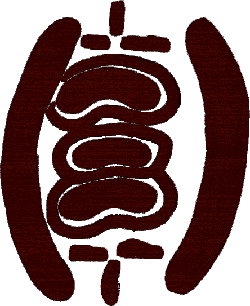Aboriginal Art Sale from the Central Australian Desert View more

Ovals On The Sides Are The Windbreaks.
The Three Dashes Are The Fires.
The Top Oval In The Centre Is The Man.
The Middle Oval Is The Baby.
The Bottom Oval Is The Woman.
These Icons Appear In The Majority Of Aboriginal Paintings. They Show People Involved In Ceremony, Camping, Hunting, Travelling And Gathering Bush Tucker.
A Campsite Is Usually Represented By A Series Of Concentric Circles. These Are Areas Occupied By Aboriginal People.
When You See One Of These Icons Within A Painting, You Can Assume That This Area Is A Fertile Part Of The Country. The Land Needs To Be Fertile For The Aboriginal People To Camp On, As These Areas Supply Food And Water Which Is Necessary For Survival.
As Described By Janet Long Nakamarra
There Are Many Different Ways People Used To Make Their Humpies, Wind Breaks And Shelters, People Would Make Long Windbreaks.
In A Single Women Camp, The Ladies Would Camp Along In A Row. Sometimes People Could Just Make Wind Breaks Each. At The End And They Would Sleep In The Middle Of The Wind Breaks. Wind And Storm Directions Can Be Changed. People Used To Face Their Wind Break Towards Westerly Winds, Easterly Winds. So Wind Breaks Can Be Changed In Many Directions.